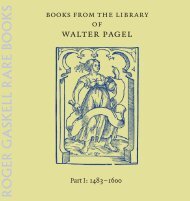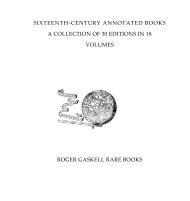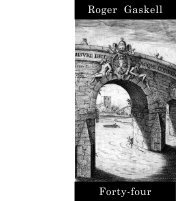pdf - Roger Gaskell Rare Books
pdf - Roger Gaskell Rare Books
pdf - Roger Gaskell Rare Books
You also want an ePaper? Increase the reach of your titles
YUMPU automatically turns print PDFs into web optimized ePapers that Google loves.
12mo: ):( 12 2):( 6 A–D8 E6 , 72 leaves, pp. [36] 107 [1]. Engraved title on<br />
):(1 verso, signed ‘F. Franck sc.’<br />
36 engraved plates numbered 1–36 (bound at the end, gathered in 3<br />
12leaf sections).<br />
135 x 78mm. A few early paper repairs (done before binding?); some<br />
dustsoiling.<br />
Binding: Contemporary vellum boards.<br />
Provenance: nineteenthcentury bookplate of the London Society for<br />
Promoting Christianity amongst the Jews, 16 Lincoln’s Inn Fields.<br />
First edition. A German edition, Kurzter EntwurV des Eigentlichen Natur-<br />
Alphabets der Heiligen Sprache was issued by the same publisher in the<br />
same year, and a Dutch version in 1679. Wellcome III p. 241; Krivatsy<br />
5426; VD17 12:153272L.<br />
A pioneer work in the theory of language in which van Helmont sought to<br />
show how the deaf may be taught to speak; and to prove that Hebrew is a<br />
‘holy language’ because the characters of the alphabet resemble the position<br />
of the lips and tongue to form the sounds with which mankind was Wrst taught<br />
to speak. Van Helmont’s method of teaching the deaf contains the basic<br />
principles of all later teaching methods (Sherrer pp. 422–424).<br />
Letters and conWgurations of the throat and tongue are shown on the<br />
thirtysix engraved plates. using these images van Helmont claimed to have<br />
successfully taught deafmutes to articulate the alphabet on Wrst sight.<br />
Van Helmont’s theories of phonetics were discussed by such contemporaries<br />
as Samuel Hartlib, John Worthington, Henry More, and Increase Mather.<br />
His neglect by later generations in Britain, Sherrer asserts, must be due to<br />
the fact that the book was never translated into English.<br />
Francis Mercurius was the only surviving son of Jan Baptiste van Helmont<br />
(1614–1698), the Paracelsian chemist. This was the younger van Helmont’s<br />
Wrst book. ‘His characteristic blend of the speculative and entirely practical<br />
was shown by his proposals arising from his theory for teaching those born<br />
deaf to speak and to understand speech.’ (Stuart Brown in ODNB).<br />
It appears that in this copy the misprint on the titlepage has been corrected<br />
by handstamping the missing X; a variant has the date correctly printed (VD17<br />
7:628249S) and the real date is conWrmed by the colophon.<br />
Ferguson I p. 380; Grace B Sherrer, ‘Francis Mercury Van Helmont: A Neglected<br />
SeventeenthCentury Contribution To The Science Of Language’, The Review of<br />
English Studies, 14 (1938) 420–427.<br />
90<br />
HELMONT, Franciscus Mercurius van (1614–1699)<br />
The paradoxal discourses of F. M. Van Helmont, concerning the<br />
macrocosm and microcosm, or the greater and lesser world, and their<br />
union set down in writing and now published by J. B.<br />
London: printed by J. C[ottrell]. and Freeman Collins, for Robert<br />
Kettlewel, at the Hand and Scepter near S. Dunstan’s Church in Fleetstreet,<br />
1685.







